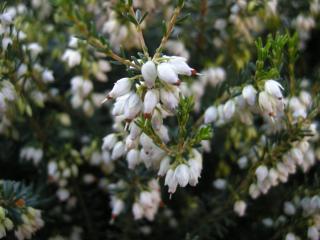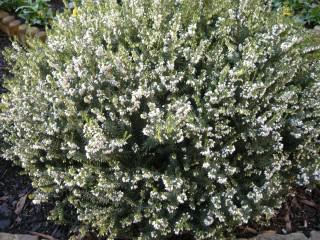
Erica carnea 'Springwood white' flower (12/12/2011, London)
Position: Full sun
Flowering period: Winter
Soil: Moist, well drained, not alkali
Eventual Height: 20cm
Eventual Spread: 40cm
Hardiness: 5a – 7b
Family: Ericaceae
Erica carnea ‘Springwood White’ is a low growing, compact evergreen shrub. The bright green leaves are needle like and are up yo 8mm long. The flowers are produced in winter to early spring and are bourne in racemes. The individual flowers are bell shaped, up to 6mm long and white in color with brown/ red tips.
Erica carnea ‘Springwood White’ is commonly known as Winter Flowering Heather, Winter Heath, Scotch Heath or Spring Heath. The species Erica carnea is native to the mountains of central and southern Europe. E. carnea is synonymous with E. herbacea and E. mediterranea. It has a long pagan history, with uses in many pagan rituals.
The etymological root of the binomial name Erica is derived from the Latin name for Heather. Carnea is also derived from the Latin carnea ‘of the flesh’ or ‘carnal/ not spiritual’, presumably in reference to its pagan history.

Erica carnea 'Springwood white' (12/12/2011, London)
The landscape architect may find Erica carnea ‘Springwood White’ useful as a low growing, winter flowering evergreen ground cover plant, particularly in acidic or nutrient poor soils. This plant is drought tolerant once established and will tolerate maritime conditions.
Ecologically, E. carnea ‘Springwood White’ is a valuable source of early nectar for bees and butterflies.
The Royal horticultural Society has given E. carnea ‘Springwood White’ their prestigious Award of Garden Merit in 1993.
E. carnea ‘Springwood White’ prefers moist, nutrient poor, well-drained soils. This plant prefers neutral to acid soils.
E. carnea ‘Springwood White’ requires little maintenance. To promote a compact habit, the plant may be cut back after flowering.

